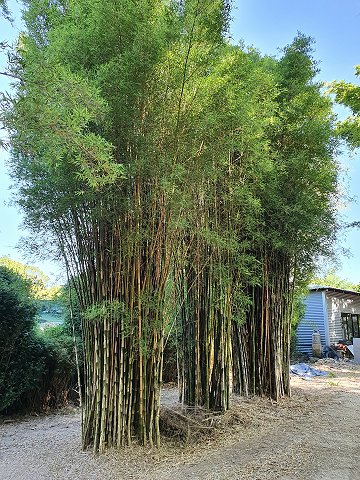
|
|
Monastery bamboo
(Thyrsostachys siamensis).
|
Monastery bamboo - Thyrsostachys siamensis
Thyrsostachys siamensis is one of two bamboo species belonging to the genus Thyrsostachys. It grows up to 7 to 13m tall. It is native to Yunnan, Myanmar, Laos, Thailand, Vietnam and naturalised in Sri Lanka, Bangladesh, Malaysia. The plant is also known as long-sheath bamboo, monastery bamboo, Thai bamboo, Thai umbrella bamboo, umbrella bamboo, and umbrella-handle bamboo.
Monastery bamboo is a perennial, evergreen, clumping bamboo with short
rhizomes. In seasonal climates the plant is deciduous in the dry season. It grows up to 7 to 13m tall.
Culm is bright green when young, which becomes yellowish green in mature and turns yellowish brown when drying. Young shoots are purplish green in color. Culm is straight. Branching only at top. Aerial roots absent. Internode length is 15–30 cm, and diameter is 3–8 cm. Culm walls are very thick which is almost solid with a very small lumen. Node prominent.
The lower two-thirds of the plants typically have few or no leaves and branches. Thick, exposed poles have something of a regal aspect, which could explain the popular nickname.
Culm sheath is yellowish green in young plants turns straw colored when mature. It is cylindrical with a triangular blade. Length of the sheath proper is 12.5–17 cm in length and 10–13 cm wide. Blade length is 3–5 cm. Auricles are small. Upper surface of the sheath covered with hairs. Lower surface of the sheath is not hairy. Sheaths persistent.
Leaf blade narrow, linear, 7-14 cm by 5-8 mm, pale green, usually glabrous; sheath striate, white hairy along the margins; ligule very short, entire, ciliate.
Infloresences borne terminally on leafy or leafless branches, many thin branchlets bearing bracteate clusters of few pseudospikelets; spikelet about 15 mm long, comprising 1 empty glume, usually 2 perfect florets and a rachilla extension bearing a rudimentary floret. Caryopsis cylindrical, about 5 by 2.5 mm, surmounted by a yellowish, glabrous, soft, long beak.
The distribution of Monastery bamboo is widespread in dry or semi-evergreen forest on poor soils, grows in mixed deciduous and teak forest in the north and north-east and pure stands often occur in hill forest in the central part, at 300-400 m altitudes, with annual rainfall of 800-1,000 mm. Occasionally grown as wind break.
One of the most useful of bamboos within its native range, it is widely utilized locally as a source of food and construction materials and is also sold to factories. The plant is cultivated in several countries outside its native range in Asia. This species is one of the most beautiful ornamental bamboos in the tropics of SE Asia, long cultivated in SE China.
It is multiplied by rhizome division of 1-year-old culms with rhizome part, roots and up to 1 m long culm, places in a moist media under 50 % shade for 2-3 months or until new roots and shoots arise and mature enough then transplanted to the field during the start of rainy season.
Like other types of bamboo, Thyrsostachys siamensis is valued as a food and in Thailand is commonly canned.
Young shoots cooked and eaten as a vegetable. They are considered to be among the best of bamboo shoots.
Young shoots are boiled and served with nam prik or added to various kinds of dish but most bamboo shoots contain high amount of uric acid, those with joint pain should avoid any dish with bamboo shoot. Young shoots are available during rainy season.
The culms are light, strong and straight. They are used in house construction and for general household uses, as well as providing raw material for cottage industries. The culms are also widely used to make baskets, chopsticks, umbrella and broom handles, handicrafts, fishing rods and they serve as raw material for paper pulp and as fuel.
This species is often used to produce umbrella handles for people of high rank and status, as well as for monks and priests.
Once harvested, the culms are traditionally submerged for 10 - 20 days in running water to reduce starch and sugar contents, and subsequently cleaned, polished and dried. For furniture making, the culms are fire cured, which requires much skill to avoid damage.
Because of its elegant appearance it is a popular ornamental plant by Buddhist monks around temples. It is also planted in rows as fences or as windbreaks.
Source:
https://en.wikipedia.org/wiki/Thyrsostachys_siamensis
https://tropical.theferns.info/viewtropical.php?id=Thyrsostachys+siamens
https://www.jircas.go.jp/project/value_addition/Vegetables/100.html
